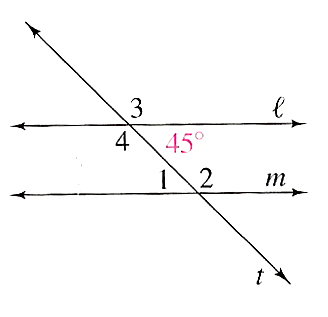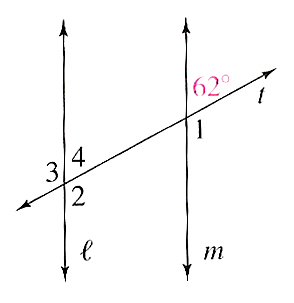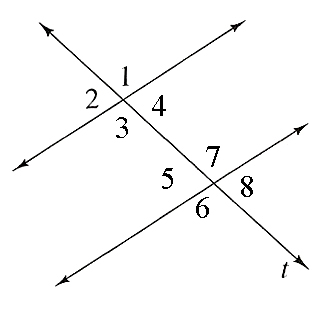Lines And Angles Quiz Questions And Answers
(145).jpg)
Can you identify the types of angles observing the orientation of lines? Take this quiz and learn more about it now! Just answers to some questions on our lines and angles quiz and test your knowledge. If you wish to learn more about the concept, we suggest you take our quiz to brush up on your knowledge! If you have a test coming up on the topic then this quiz is perfect for you! Just pick the correct answer to prepare well! Good luck studying!
- 1.
Angles 3 and 4 are __________________.
- A.
Complimentary
- B.
Supplementary
- C.
Vertical
- D.
Corresponding
Correct Answer
B. SupplementaryExplanation
Angles 3 and 4 are supplementary angles because they are adjacent angles that form a straight line. Supplementary angles add up to 180 degrees. This is a fundamental concept in geometry and is often used to solve for unknown angles in various geometric figures.Rate this question:
-
- 2.
If the angle shown in pink is labled 45 degrees, what is the measurement of angle 1?
- A.
45 degrees
- B.
135 degrees
- C.
90 degrees
- D.
Unable to determine
Correct Answer
A. 45 degreesExplanation
Angle 1 is the same as the angle shown in pink, which is labeled as 45 degrees. Therefore, the measurement of angle 1 is also 45 degrees.Rate this question:
-
- 3.
Angles 1 and 2 are ___________ angles.
- A.
Interior Adjacent Angles
- B.
Exterior Consecutive Angles
- C.
Alternate interior
- D.
Vertical Angles
Correct Answer
C. Alternate interiorExplanation
When two parallel lines are cut by a transversal, the pairs of angles on opposite sides of the transversal and inside the two lines are called alternate interior angles. In the given figure, angles 1 and 2 are on opposite sides of the transversal and inside the two lines, so they are alternate interior angles.Rate this question:
-
- 4.
In geometry, what type of angle measures exactly 90 degrees?
- A.
Acute angle
- B.
Obtuse angle
- C.
Right angle
- D.
Reflex angle
Correct Answer
C. Right angleExplanation
Right angle: This is the correct answer. A right angle measures exactly 90 degrees, forming a perfect L-shape, like the corner of a square or rectangle.Rate this question:
-
- 5.
When you add angle 1 and angle 4's measurements, you get how many degrees? (Give a number.)
Correct Answer
180Explanation
When you add the measurements of angle 1 and angle 4, you get a sum of 180 degrees.Rate this question:
- 6.
Which of the following pairs represents Alternate Exterior Angles?
- A.
1,2
- B.
2,3
- C.
4,5
- D.
1,6
Correct Answer
D. 1,6 -
- 7.
Which of the following pairs represents Alternate Interior Angles?
- A.
4,5
- B.
6,7
- C.
2,8
- D.
1,8
Correct Answer
A. 4,5 -
- 8.
Adjacent angles share a _______ and have a common side. (One word - spelling counts!)
Correct Answer
vertexExplanation
Adjacent angles share a vertex, which is the point where the two angles meet. They also have a common side, meaning that one side of each angle is the same.Rate this question:
- 9.
Two angles whose measurements add up to 90 degrees are said to be _____________.
- A.
Congruent
- B.
Comparable
- C.
Complementary
- D.
Critical
Correct Answer
C. ComplementaryExplanation
Complementary angles are two angles that add up to 90 degrees. They can be adjacent (sharing a side) or non-adjacent. Understanding complementary angles is crucial in geometry and trigonometry for solving problems involving right angles and triangles.Rate this question:
-
- 10.
True or False. Think about this one....Assuming the lines are parallel in this diagram, if you added ALL the Alternate Interior Angles together, and then you added the measurements of ALL the Alternate Exterior Angles together, the 2 total measurements would be equal to each other.
- A.
True
- B.
False
Correct Answer
A. TrueExplanation
If the lines in the diagram are parallel, then the alternate interior angles and alternate exterior angles are congruent. Therefore, if you add all the measurements of the alternate interior angles together and add all the measurements of the alternate exterior angles together, the two totals will be equal to each other. This is because alternate interior angles and alternate exterior angles are formed by a transversal intersecting parallel lines, and they are always congruent.Rate this question:
-
- 11.
What term best describes angles 7 and 6?
- A.
Acute
- B.
Obtuse
- C.
Scalene
- D.
Adjacent
Correct Answer
D. AdjacentExplanation
Angles 7 and 6 are adjacent angles because they share a common side and a common vertex, and they do not overlap. Adjacent angles are next to each other and form a linear pair if they add up to 180 degrees. Vertical angles are opposite each other when two lines intersect, corresponding angles are on the same side of the transversal in corresponding positions, and alternate interior angles are on opposite sides of the transversal but inside the parallel lines.Rate this question:
-
- 12.
True or False. Angles 4 and 7 are congruent.
- A.
True
- B.
False
Correct Answer
B. FalseExplanation
The question states that angles 4 and 7 are congruent. However, since the answer is false, it means that angles 4 and 7 are not congruent.Rate this question:
-
Quiz Review Timeline +
Our quizzes are rigorously reviewed, monitored and continuously updated by our expert board to maintain accuracy, relevance, and timeliness.
-
Current Version
-
Jan 21, 2025Quiz Edited by
ProProfs Editorial Team -
Feb 04, 2009Quiz Created by
Annefowler
 Back to top
Back to top





